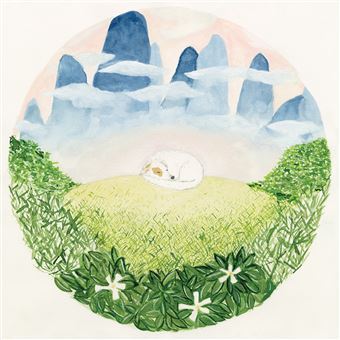Ben Hackett’s Songs for Sleeping Dogs is a study in subconscious beauty. Hackett didn’t set out to make an album of meditative flowstate sonics when he began recording the various pieces that eventually revealed themselves to be a collective whole. In fact, he didn’t set out to make an album at all. The title Songs for Sleeping Dogs is a quite literal reference to the conditions these songs grew in, with Hackett working softly during quiet hours in his home studio space, trying not to wake the slumbering dog or the rest of the household. Sometimes starting with composed arrangements, but just as often building on melodic figures he realized he’d been absentmindedly playing while thinking about something else, Hackett slowly assembled a private collection of unobtrusive, observational grandeur. The final product reaches the unlikely nexus point of whisper-thin subtlety and profound musical depth, with Hackett playing each of the dozens of different woodwinds, acoustic instruments, electronics, and other components of the songs. Every sound dissolves into the next for an album that breathes, reacts, and considers, and all of it happens within an atmosphere so soft that the experience itself feels almost accidental.
Originally from Chattanooga, Tennessee, Hackett has lived in Athens, Georgia since 2012 after his band New Madrid recorded their first album at one of Athens’s most celebrated studios, Chase Park Transduction. Since his move, Hackett has established himself as part of Athens’ musical community, now working at Chase Park as an engineer and session player. In addition to doing session work both at the studio and remotely, tracking bass, woodwinds, and synths for hire, Hackett also keeps busy playing in a bunch of bands around town, among them Rose Hotel, Zach Ritter and the Eternal Soup, and backing up Athens artists like David Barbe and McKendrick Bearden.
In addition to all of this activity, Hackett’s practice included daily recording and sonic notekeeping in the little music room at his house. He’d record there most days, sometimes ideas for future songs, sometimes just a capture of whatever mood was occurring. Songs for Sleeping Dogs materialized in this little room between 2022 and 2024, with most of the pieces that made the final record arriving fully formed in the moment. Almost every track was born of an undiluted spark of inspiration, and Hackett took pains to hold onto that spark by prioritizing immaculate vibe over technically perfect performances. Eventually the album was whittled down from over 30 songs to the twelve that appear on the final cut, with Jason Kingsland (Belle and Sebastian, Deerhunter, Youth Lagoon) coming in to help finalize the mixing process. Hackett’s homespun sounds were fed through a half-inch tape machine and translated with subtlety into the perfect headphone experience for the enlightened heads.
While the songs were being realized, Hackett kept his creations organized by giving them titles that corresponded with what was happening as they were being made. Rather than looking at sterile dates as markers of time, tracks had real-time names like “Tombo goes on a walk and we order Indian food” or “Reflection Pond Ripple.” Choosing pictorial song titles instead of mere data is part of the evocation that happens throughout the album. The music indeed feels like the scenes set by the titles, be it the relaxed bathwater splash of a sleepy synth sequence or the reflective walk after dark where each step is supported by the dreamy float of stacked clarinets and the walker overhears friendly front porch conversations in the form of ambling nylon string guitar figures.
Somewhere between a post-dusk neighborhood full of warmly lit porches and a foggy, curious dream landscape is where Hackett architects Songs for Sleeping Dogs. At times, the album feels like a less nervy reading of the possible musics conceptualized in Jon Hassell’s Fourth World series, with the melt of the woodwinds making more space for authentic exploration and a decidedly non-academic approach gifting the proceedings with a glowing, open feel. In other stretches, the songs can echo by turns the patient simplicity of Hiroshi Yoshimura’s ambient naturalism, the playful flutter of Penguin Cafe Orchestra, Robert Stillman’s deftly orchestrated wandering, or the organic feel of Haruomi Hosono’s pre-Yellow Magic Orchestra solo material. Ultimately, Songs for Sleeping Dogs exists within a liminal space of its own, one stripped of ego and void of the now-expected swells and silences of modern ambient music. The sounds are thoughtful and strange, saturated with quiet contentment that never overstates its message or raises its voice for fear of waking the dozing dog. It’s a world of multiple paths that all lead to the same destination, with signs along the way reassuring us in new languages. All of it smiling and grateful, every sublime moment born of chance.
